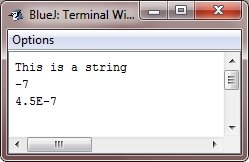- Java Programming Basics
- Java Tutorial
- Java Overview
- Java Environment Setup
- Java Program Structure
- Java Basic Syntax
- Java First Program
- Java Constants
- Java Separators
- Java Keywords
- Java Data Types
- Java Data Types
- Java Integers
- Java Floating Point
- Java Characters
- Java Booleans
- Java Numbers
- Java Programming Variables
- Java Variables
- Java Variable Types
- Java Variable Scope
- Java Type Conversion
- Java Type Casting
- Java Auto Type Promotion
- Java Type Promotion Rules
- Java Programming Arrays
- Java Arrays
- Java One Dimensional Array
- Java Multidimensional Array
- Java Programming Operators
- Java Operators
- Java Arithmetic Operators
- Java Increment Decrement
- Java Bitwise Operators
- Java Left Shift
- Java Right Shift
- Java Relational Operators
- Java Boolean Logical Operators
- Java Ternary(?) Operator
- Java Operator Precedence
- Java Control Statements
- Java Decision Making
- Java if if-else if-else-if
- Java switch Statement
- Java Loops
- Java while Loop
- Java do-while Loop
- Java for Loop
- Java for-each Loop
- Java Nested Loops
- Java break Statement
- Java continue Statement
- Java Class Object Method
- Java Classes and Objects
- Java Class
- Java Object
- Java new Operator
- Java Methods
- Java Constructors
- Java this Keyword
- Java Stack
- Java Overloading Recursion
- Java Method Overloading
- Java Constructor Overloading
- Java Object as Parameter
- Java Call by Value Reference
- Java Returning Objects
- Java Recursion
- Java Modifier Types
- Java Encapsulate Poly String
- Java Encapsulation
- Java Polymorphism
- Java Nested Inner Class
- Java Strings
- Java Command Line Arguments
- Java Variable Length Arguments
- Java Inheritance Abstraction
- Java Inheritance
- Java super Superclass
- Java Multilevel Hierarchy
- Java Method Overriding
- Java Abstraction
- Java Packages Interfaces
- Java Packages
- Java Access Protection
- Java Import Statement
- Java Interfaces
- Java Programming Exceptions
- Java Exception Handling
- Java try catch
- Java throw throws
- Java finally Block
- Java Built In Exceptions
- Java Exception Subclasses
- Java Chained Exceptions
- Java Multithreading
- Java Multithreading
- Java Thread Model
- Java Main Thread
- Java Create Thread
- Java Thread Priorities
- Java Synchronization
- Java Inter Thread Communication
- Java Suspend Resume Stop Thread
- Java Get Thread State
- Java Enum Autobox Annotation
- Java Enumerations
- Java Type Wrappers
- Java Autoboxing
- Java Annotation
- Java Marker Annotations
- Java Single Member Annotation
- Java Built In Annotations
- Java Type Annotations
- Java Repeating Annotations
- Java Data File Handling
- Java Files I/O
- Java Streams
- Java Read Console Input
- Java Write Console Output
- Java PrintWriter Class
- Java Read Write Files
- Java Automatically Close File
- Java Programming Advance
- Java Date and Time
- Java Regular Expressions
- Java Collections Framework
- Java Generics
- Java Data Structures
- Java Network Programming
- Java Serialization
- Java Send Email
- Java Applet Basics
- Java Documentation
- Java Programming Examples
- Java Programming Examples
Java PrintWriter Class
Although using System.out to write to the console is acceptable, its use is probably best for the debugging purposes or for sample programs.
For real-world programs, the recommended method of writing to the console when using Java is through the PrintWriter stream.
The PrintWriter is one of the character-based classes. Using a character-based class for the console output makes internationalizing your program easier.
The PrintWriter defines several constructors. The one we will use is shown below :
PrintWriter(OutputStream outputStream, boolean flushingOn)
Here, outputStream is an object of type OutputStream, and flushingOn controls whether Java flushes the output stream every time a println() method (among others) is called. If flushingOn is true, flushing automatically takes place. If false, flushing is not automatic.
The PrintWriter supports the print() and println() methods. Thus, you can use these methods in the same way as you used them with System.out. If an argument is not a simple type, the PrintWriter methods call the object's toString() method and then display the result.
To write to the console by using the PrintWriter, specify System.out for the output stream and automatic flushing. For example, the following line of code creates a PrintWriter that is connected to console output:
PrintWriter pw = new PrintWriter(System.out, true);
Java PrintWriter Example
The following application illustrates using a PrintWriter to handle console output:
/* Java Program Example - Java PrintWriter Class
* This program demonstrate the PrintWriter */
import java.io.*;
class PrintWriterDemo
{
public static void main(String args[])
{
PrintWriter prnwrt = new PrintWriter(System.out, true);
prnwrt.println("This is a string");
int i = -7;
prnwrt.println(i);
double d = 4.5e-7;
prnwrt.println(d);
}
}
The output from this Java program is shown below :

Remember, there is nothing wrong with using System.out simple text output to the console when you are learning Java or debugging your programs. However, using the PrintWriter makes your real-world applications easier to internationalize. Because no advantage gained by using the PrintWriter in the simple programs, we will continue to use System.out to write to the console.
Examples on Files in Java
Here are some examples related to files in Java, you can go for.
- Read File in Java
- Write to File Java
- Read & Display File in Java
- Copy File in Java
- Merge two Files in Java
- List files in a Directory Java
- Delete File in Java
« Previous Tutorial Next Tutorial »